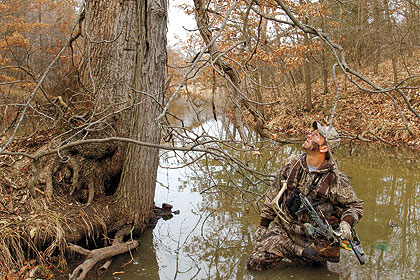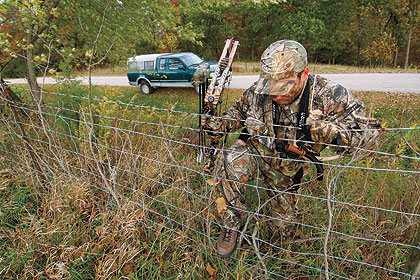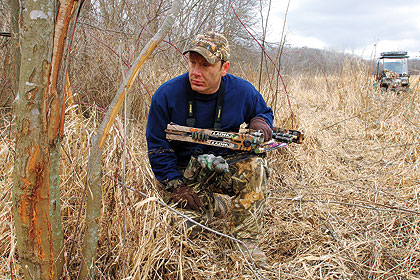October 28, 2010
By Bill Winke
€¦is keeping your presence a secret.
By Bill Winke
Trends come and go, but you can count on the bedrock of all buck-hunting strategy: keep the bucks you're hunting from knowing you are hunting them. While focusing on the fundamentals may not be as glamorous as trying out the latest scent or call, it is the only way to be consistently successful.
Most of my strategizing is spent trying to figure out exactly where to place each boot print to minimize impact on the bucks I hunt. Here's a step-by-step look at a typical day in the field:
Advertisement
Timing
Some of my friends get to their morning stands as much as an hour before first light. This is not for me. My ideal morning has me hooking up my safety harness just as legal shooting time begins. Instead of arriving an hour early, I would rather start walking when I can first see the ground. That way, I can walk quickly and quietly as I avoid branches.
People talk about getting in early so they can let the woods settle down after their passing. That doesn't make any sense. The woods don't settle down. The deer you spook run off — that is not settling down. I would rather keep my scent out of the woods at times when I can't shoot. If a good buck comes by the stand, I don't want him to encounter anything but an arrow. Sitting there in the dark waiting for legal shooting time seems counterproductive.
Advertisement
Where You Park Matters
Picking the right place to park your vehicle is a big deal, much bigger than many bowhunters realize. A friend of mine likens this to beating a bass drum outside someone's house and then trying to sneak in and rob them. They are on to you well before you ever get to the porch. Same thing in the deer woods. You are a burglar; you have to park a long way from where you hunt. I often walk a half-mile or more along county roads just to get to the spot where I start walking through the timber. On a still day, deer can literally hear you stopping and getting ready for a good distance.
 The easiest, most direct route to your stand is rarely the best way to keep the element of surprise in your favor. If you can take advantage of creeks or ponds to slip in undetected, you can keep the deer from knowing you are hunting them. |
If you crunch to a halt in a spot where people rarely park, the deer will interpret the disturbance as a threat. Keep your distance, do more walking and you will shoot more bucks.
The only exception to this rule occurs when you can park in a place where people routinely park, such as someone's driveway. Maybe you can slip into a spot where farmers unload grain or leave their equipment, but just pulling off the road, jumping the fence and walking 200 yards to your stand generally won't get it done — especially in the morning. The deer know you are there.
Entry Route
I stress out more over entry routes than any other aspect of deer hunting. Most of my off-season strategy time goes into figuring out better ways to get to my stands. After a few years of hunting an area, I usually have a good idea where I need to be, but getting there is not always so clear. Fine-tuning how I get to my stands is a lifelong challenge. If you take your success seriously, you will invest more time in this aspect of the hunt than any other.
Of course, it all comes down to keeping the deer from seeing, hearing or smelling you as you pass. You also want to keep them from smelling your ground scent where you walked. If only we could tunnel in to our stands, or parachute in, deer hunting would be a lot easier. Until you figure out how to pull that off, you are stuck sorting out all your options. Entry is such an important part of the puzzle that you are actually better off ignoring sign and scouting for the best access routes first and then finding the best stand locations nearby rather than scouting the best sign first and then trying to figure out how to get to the stand later. In other words, do it backwards.
 Be sure to park far enough away from your stand that the deer can't hear you stop and get ready. Parking too close is a mistake many bowhunters make. |
I use a lot of ditches, creeks and standing cornfields to get to my stand sites. Look for low spots in fields and anything else you can use to keep out of sight.
It is also important to avoid places where deer are likely to be when you are approaching your stands. That means avoiding feeding areas in the morning and bedding areas on your way to an afternoon stand. Go well out of your way if you have to. The short and easy route isn't always best.
 Restrict your in-season scouting to the downwind fringes of your hunting area. Look for sign and possible stand locations near the edges before venturing deeper into sanctuaries. |
| SCOUT SMART | 

In human terms, busting into a buck's sanctuary is like a stranger breaking into your home. You'd know the signs at first glance — a broken door lock, muddy boot tracks, overturned furniture, etc. — and you'd react immediately. If we aren't careful, deer can read the signs of our intrusion just as clearly and react just as dramatically. One of the best ways you can reduce your impact and keep your hunting area fresh is to stay out of the woods until the day you start hunting. However, there are likely to be times when you are forced to scout either right before or during the season. When that happens, scout field edges for big tracks and fringe cover for trails, rubs and scrapes. Always stay on the downwind side of the cover to keep your scent from reaching the deer.The only exceptions are those places that routinely see human activity, such as near residential areas or active farming operations. In that case, it is safe to scout a bit harder by first announcing your presence by driving close, slamming doors, starting a chainsaw and otherwise clearing the deer out before you even set foot in their sanctuary. That way, you avoid scaring them badly by surprising them. They don't like surprises.Rather than argue about which kinds of boots work best to control scent, I will instead focus on where most ground scent really comes from: your pants. Deer smell human odor on the low-lying vegetation that brushes against your pants. Keep that in mind when preparing your stand sites, when selecting your entry and exit routes and even when choosing your gear. I have used the Elimitrax over-boot system with success in areas with a lot of ground cover. I have even used PVC waders to reduce or eliminate human scent in areas with tall grass and brush. It is a pain, but success comes down to doing the small things well. This is one of those small things you need to do well.
|
|
Don't Get Picked Off
OK, so I have made it to the tree; the battle to avoid detection isn't over yet. Obviously, I play the wind on every hunt — no compromises. I also do all I can to keep any deer passing downwind from smelling me. There are things you can do to significantly reduce your scent profile. Even if you never eliminate every single molecule of man-stink, it is worth the effort. By reducing your scent, you reduce the distance at which a deer can smell you, and that helps keep your stand area fresh longer.
Also, you can't let the deer spot you in the tree. It is hard to fool a deer — especially an old doe — that has seen you in the tree. Every time she comes into that area, she will look for you — stomping and blowing. The stand will never be good again until either that deer is dead or the next season rolls around. It is better to keep all the deer from seeing you in the first place. I like to place my stand among branches. By setting up with the larger limbs at waist height, I can shoot over them while they break up my outline.
Exit Route
It is very short-term thinking to believe your exit route doesn't matter. Sure, the hunt is over and the deer will have time to recover before next weekend. That sounds good, and you can probably use that argument to justify the path of least resistance back to the vehicle. Unfortunately, it isn't true. When deer discover you, it affects your hunting area for longer than a few days. That's why the first time you hunt a stand is usually your best chance for shooting a nice buck from it. Even when you rest a stand, it is never quite as good as the first time.
Successful deer hunting comes down to doing the small, fundamental things really well. The best deer hunters I know aren't doing different things than everyone else; they are just doing the same things better. One of the most important aspects of the hunt is simply keeping deer from knowing you are hunting them. If you can do that really well, you will enjoy more than your share of success.
